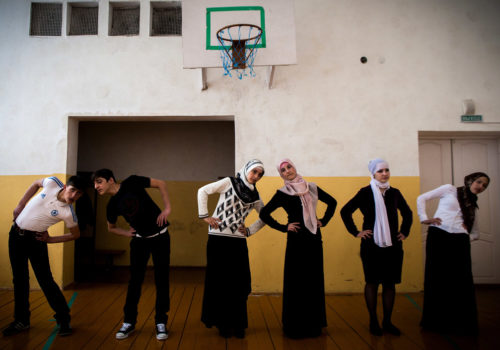This is the second exhibition at Open Society’s new space and the 21st edition of their program Moving Walls. Five photographers, aged 25 to 47, working in Africa, Asia, Europe and Latin America, are being honored this year for their singular approach of history and their ways of examining worrying living conditions.
In Chechnya, Diana Markosian documents the struggle of women since the end of the conflict in 2009 as they are gradually losing their status as individuals and becoming the property of men. For two years, Markosian lived under these conditions and took a special interest in the case of young women, those her age, teenagers deprived of those magical moments essential to the development of one’s identity.
In Hong Kong, another attack on freedom is concealed by the explosion of neon lights and consumerism. Mark Leong, who has traveled regularly Hong Kong since 1989, fears that it’s becoming, “just another freedom-deficient Chinese city.” With the support of National Geographic, he has developed a series of garish compositions, cataloguing the glaring signs of growing inequality. Protesting artists risk arrest. Prostitutes save up enough money to buy an apartment on the mainland. Taxi drivers are forced to acquire so many telephones and CB radios to intercept fares that their dashboards start looking like airplane cockpits. On weekends, Indonesian immigrants crowd into grassy areas beneath overpasses as they might on a sunny day at the beach. The cacophony is unsettling.
In contrast to these neon lights are the decaying remnants of Greek industry, factories where sugar, plastic and traditional rugs were once made. Nikos Pilos photographs them like monuments, the disappearing ruins of a bygone era. It could be Detroit after the economic crash. In a photograph of an abandoned office, a map of Greece still hangs on the wall, as if its trace were all that the crisis had left behind.
The vestiges of another history are seen in the shoes soberly photographed by Shannon Jensen. They were once worn by South Sudanese refugees of all ages who survived the long walk to the border. Through this simple, universal object, Jensen reveals much about the conditions of their exile, more than in her three other reports on the country, filled with tearful, weary faces. Each pair is accompanied by a story about their owners, who offered to let Jensen photograph their shoes once they realized what she attempted to do.
This is another strength of Moving Walls to represent a variety of photographic styles. João Pina examines Operation Condor, a neglected chapter in the Cold War that plagued Argentina, Brazil, Uruguay, Paraguay, Bolivia and Chile in the 1970s and ‘80s. Condor was a transnational agreement aimed to annihilate political opposition. An estimated 30,000 people disappeared in Argentina only. Driven to the cause on account of his family history, Pina has spent the past eight years compiling visual evidence of this sordid plot. He meets with the families whose relatives disappeared, accompanies policemen as they exhume bodies buried 30 years ago, returns to abandoned prisons and torture centers and digs through police files, fighting to make sure this story doesn’t end up, like its victims, at the bottom of the ocean. While the trials condemning the instigators of this murderous system are slowly opening, this long-term report reveals the history that the defendants, as seen hiding their face in João Pina’s recent images, seem unwilling to confront.
Moving Walls 21
January 29 – October 6 octobre 2014
Open Society Foundations
224 West 57th Street
New York, NY 10019
USA
http://www.opensocietyfoundations.org/moving-walls/21
http://www.shannon-jensen.com/
http://www.joao-pina.com
http://www.reduxpictures.com/Photographer/Mark-Leong
http://www.dianamarkosian.com/open
http://nikospilos.com/galleries/gallery/whatsnew/
















